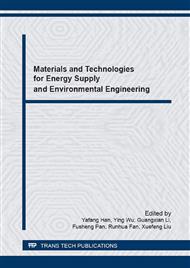[1]
Dreiss CA. Wormlike micelles: where do we stand? Recent developments, linear rheology and scattering techniques, Soft Matter. 8(2007) 956-970.
DOI: 10.1039/b705775j
Google Scholar
[2]
Candau SJ, Oda R, Linear viscoelasticity of salt-free wormlike micellar solutions, Colloids Surf A Physicochem Eng Asp. 183(2001) 5-14.
DOI: 10.1016/s0927-7757(01)00535-0
Google Scholar
[3]
Raghavan SR, Kaler EW, Highly viscoelastic wormlike micellar solutions formed by cationic surfactants with long unsaturated tails, Langmuir. 17(2001) 300-306.
DOI: 10.1021/la0007933
Google Scholar
[4]
Rekha Goswami Shresha, Lok Kumar Shrestha, Kenji Aramaki, Wormlike micelles in mixed amino acid-based anionic/nonionic surfactant systems, Journal of Colloid and Interface Science. 322(2008) 596-604.
DOI: 10.1016/j.jcis.2008.03.009
Google Scholar
[5]
Yuichiro Takamatsu, Naoyuki Iwata, Kazuyuki Tsubone, Synthesis and aqueous solution properties of novel anionic heterogemini surfactants containing a phosphate headgroup, Journal Of Colloid and Interface Science. 338(2009) 229-235.
DOI: 10.1016/j.jcis.2009.06.016
Google Scholar
[6]
W. Al-Sadat, M.S. Nasser, F. Chang, H.A. NasrElDin, I.A. Hussein, Laboratory evaluation of the effects of additives and pH on the thermorheological behavior of a viscoelastic zwitterionic surfactant used in acid stimulation, Journal of Petroleum Science and Engineering. 122(2014).
DOI: 10.1016/j.petrol.2014.08.006
Google Scholar
[7]
Caili Dai, Kai Wang, Yifei Liu, Hui Li, Ziyang Wei, Mingwei Zhao, Reutilization of Fracturing Flowback Fluids in Surfactant Flooding for Enhanced Oil Recovery, Energy&Fuels. 29(2015) 2304-2311.
DOI: 10.1021/acs.energyfuels.5b00507
Google Scholar
[8]
P. Parekh, D. Varade, J. Parikh, P. Bahadur, Anionic-cationic mixed surfactant systems: Micellar interaction of sodium dodecyl trioxyethylene sulfate with cationic Gemini surfactants, Colloids and Surfaces A: Physicochemical and Engineering Aspects. 385(2011).
DOI: 10.1016/j.colsurfa.2011.05.057
Google Scholar
[9]
Zengying Zhao, Guocheng Lu, Visco-elastic properties of VES Diverting Acid for carbonate reservoirs, Chinese Journal of Chemical Engineering. 18(2010) 511-514.
DOI: 10.1016/s1004-9541(10)60251-0
Google Scholar
[10]
Haiming Fan, Lingwei Meng, Yongjian Wang, Xiaoyan Wu, Shuren Liu, Yuan Li, Wanli Kang, Superior thermal stability gel emulsion produced by low concentration Gemini surfactant, Colloids and surfaces A: Physicochem. Eng. Aspects. 384(2011) 194-199.
DOI: 10.1016/j.colsurfa.2011.03.058
Google Scholar
[11]
W. Al-Sadat, M.S. Nasser, F. Chang, H.A. NasrElDin, I.A. Hussein, Rheology of a viscoelastic zwitterionic surfactant used in acid stimulation: Effects of surfactant and electrolyte concentration, Journal of Petroleum Science and Engineering. 124(2014).
DOI: 10.1016/j.petrol.2014.09.014
Google Scholar
[12]
Bojan Sarac, Marija Bester. R, Temperature and salt-induced micellization of dodecyltrimithylammonium chloride in aqueous solution: A thermodynamic study, Journal of Colliod and Interface Scinece. 338(2009) 216-221.
DOI: 10.1016/j.jcis.2009.06.027
Google Scholar
[13]
David Lopez-Diaz, Erick Sarmiento-Gomez, Cristina Garza, Rolando Castillo, A rheological study in the dilute regime of the worm-micelle fluid made of zwitterionic surfactant(TDPS), anionic surfactant(SDS) and brine, Journal of Colloid and Interface Science. 348(2010).
DOI: 10.1016/j.jcis.2010.03.038
Google Scholar
[14]
Xiaomei Pei, Zonghui Xu, Binglei Song, Wormlike micelles formed in catanionic systems dominated by cationic Gemini surfactant: Synergistic effect with high efficiency, Colloids and Surfaces A: Physicochemical and Engineering Aspects. 443(2014).
DOI: 10.1016/j.colsurfa.2013.12.007
Google Scholar
[15]
Fu Chen, Yue Wu, Weng Wang, Renlan Zha, Self-assembly networks of wormlike micelles and hydropobically modified polyacrylamide with high performance in fracturing fluid application, Colloid Plym Sci. 293(2015) 687-697.
DOI: 10.1007/s00396-014-3454-y
Google Scholar


